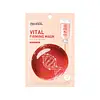What's inside
What's inside
 Key Ingredients
Key Ingredients

No key ingredients
 Benefits
Benefits

 Concerns
Concerns

No concerns
 Ingredients Side-by-side
Ingredients Side-by-side

Water
Skin ConditioningGlycerin
HumectantDipropylene Glycol
HumectantHydrolyzed Collagen
EmollientPanthenol
Skin ConditioningAllantoin
Skin ConditioningCarbomer
Emulsion StabilisingSodium Polyacrylate
AbsorbentAdenosine
Skin ConditioningPolysorbate 80
EmulsifyingTromethamine
BufferingDisodium EDTA
Ethylhexylglycerin
Skin ConditioningCaprylyl Glycol
EmollientChlorphenesin
AntimicrobialParfum
MaskingWater
Skin ConditioningDipropylene Glycol
HumectantGlycereth-26
HumectantGlycerin
HumectantPropanediol
SolventCeramide AP
Skin Conditioning1,2-Hexanediol
Skin ConditioningButylene Glycol
HumectantAllantoin
Skin ConditioningSodium Carbomer
Emulsion StabilisingHydroxyethylcellulose
Emulsion StabilisingCoptis Japonica Root Extract
Skin ConditioningCamellia Sinensis Leaf Extract
AntimicrobialZingiber Officinale Root Extract
MaskingGlycyrrhiza Glabra Root Extract
BleachingEthylhexylglycerin
Skin ConditioningDipotassium Glycyrrhizate
HumectantDisodium EDTA
Polyglyceryl-10 Myristate
Skin ConditioningPolyglyceryl-10 Laurate
Skin ConditioningAloe Barbadensis Leaf Extract
EmollientSodium Hyaluronate
HumectantOlea Europaea Fruit Oil
MaskingCitrus Aurantium Bergamia Fruit Oil
MaskingBeta-Glucan
Skin ConditioningCanarium Luzonicum Gum Nonvolatiles
MaskingCupressus Sempervirens Oil
MaskingWater, Dipropylene Glycol, Glycereth-26, Glycerin, Propanediol, Ceramide AP, 1,2-Hexanediol, Butylene Glycol, Allantoin, Sodium Carbomer, Hydroxyethylcellulose, Coptis Japonica Root Extract, Camellia Sinensis Leaf Extract, Zingiber Officinale Root Extract, Glycyrrhiza Glabra Root Extract, Ethylhexylglycerin, Dipotassium Glycyrrhizate, Disodium EDTA, Polyglyceryl-10 Myristate, Polyglyceryl-10 Laurate, Aloe Barbadensis Leaf Extract, Sodium Hyaluronate, Olea Europaea Fruit Oil, Citrus Aurantium Bergamia Fruit Oil, Beta-Glucan, Canarium Luzonicum Gum Nonvolatiles, Cupressus Sempervirens Oil
 Reviews
Reviews

Ingredients Explained
These ingredients are found in both products.
Ingredients higher up in an ingredient list are typically present in a larger amount.
Allantoin is a soothing ingredient known for its protective and moisturizingg properties. Because of this, it is often added to products with strong active ingredients.
Studies show higher concentrations of this ingredient can promote wound healing.
Though it can be derived from the comfrey plant, allantoin is produced synthetically for cosmetic products to ensure purity.
Learn more about AllantoinDipropylene Glycol is a synthetically created humectant, stabilizer, and solvent.
This ingredient helps:
Dipropylene glycol is technically an alcohol, but it belongs to the glycol family (often considered part of the ‘good’ alcohols). This means it is hydrating and gentle on skin unlike drying solvent alcohols like denatured alcohol.
As a masking agent, Dipropylene Glycol can be used to cover the smell of other ingredients. However, it does not have a scent.
Studies show Dipropylene Glycol is considered safe to use in skincare.
Learn more about Dipropylene GlycolDisodium EDTA plays a role in making products more stable by aiding other preservatives.
It is a chelating agent, meaning it neutralizes metal ions that may be found in a product.
Disodium EDTA is a salt of edetic acid and is found to be safe in cosmetic ingredients.
Learn more about Disodium EDTAEthylhexylglycerin (we can't pronounce this either) is commonly used as a preservative and skin softener. It is derived from glyceryl.
You might see Ethylhexylglycerin often paired with other preservatives such as phenoxyethanol. Ethylhexylglycerin has been found to increase the effectiveness of these other preservatives.
Glycerin is already naturally found in your skin. It helps moisturize and protect your skin.
A study from 2016 found glycerin to be more effective as a humectant than AHAs and hyaluronic acid.
As a humectant, it helps the skin stay hydrated by pulling moisture to your skin. The low molecular weight of glycerin allows it to pull moisture into the deeper layers of your skin.
Hydrated skin improves your skin barrier; Your skin barrier helps protect against irritants and bacteria.
Glycerin has also been found to have antimicrobial and antiviral properties. Due to these properties, glycerin is often used in wound and burn treatments.
In cosmetics, glycerin is usually derived from plants such as soybean or palm. However, it can also be sourced from animals, such as tallow or animal fat.
This ingredient is organic, colorless, odorless, and non-toxic.
Glycerin is the name for this ingredient in American English. British English uses Glycerol/Glycerine.
Learn more about GlycerinWater. It's the most common cosmetic ingredient of all. You'll usually see it at the top of ingredient lists, meaning that it makes up the largest part of the product.
So why is it so popular? Water most often acts as a solvent - this means that it helps dissolve other ingredients into the formulation.
You'll also recognize water as that liquid we all need to stay alive. If you see this, drink a glass of water. Stay hydrated!
Learn more about Water